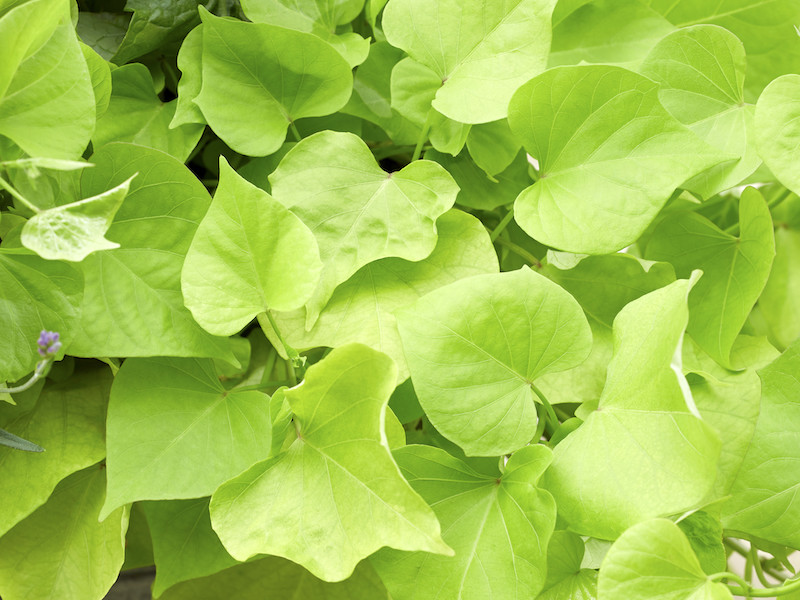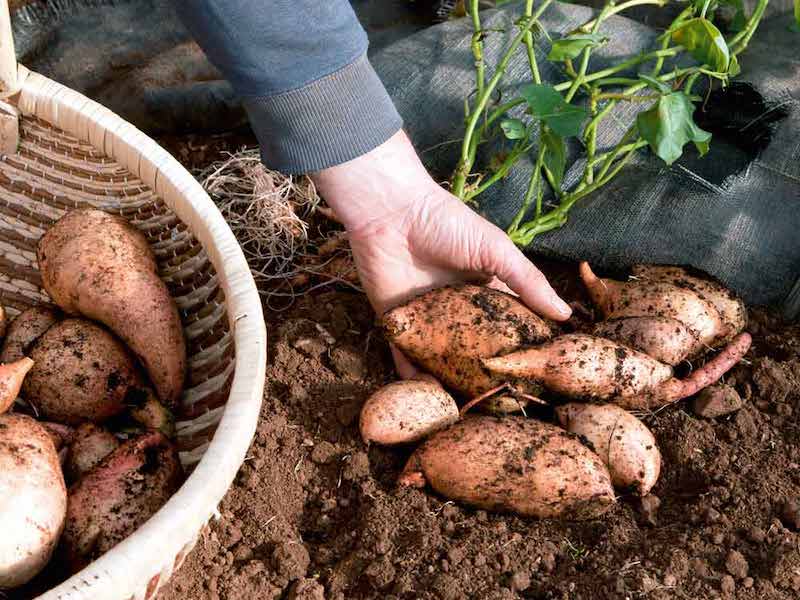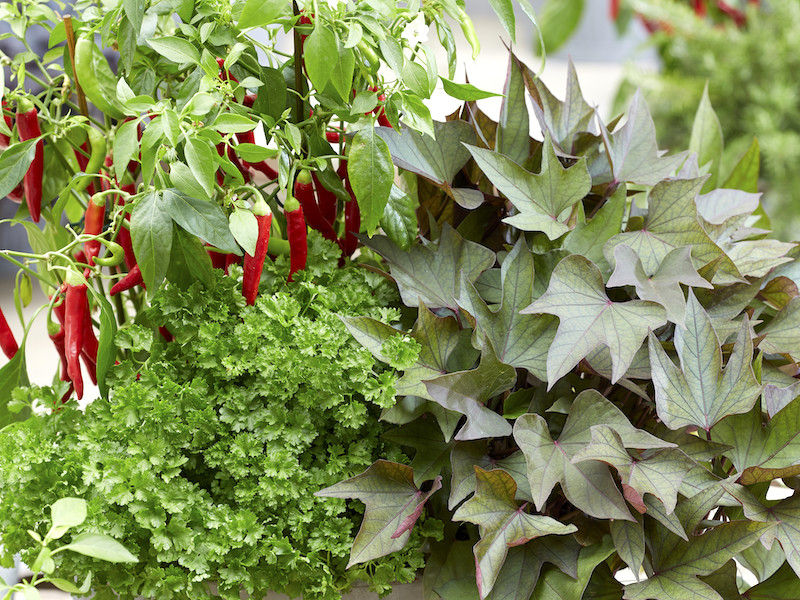Sweet potatoes are exotic, delicious, and fun to grow at home. With specially developed varieties now available in the UK, growing these tropical vines is easier than ever. Read our ultimate guide to help you successfully plant and harvest these colourful tubers.
What is a sweet potato?
A sweet potato(Ipomoea batatas) is a perennial vine, originating from central and South America, that produces large, starchy, sweet-tasting underground tubers. Packed with goodness, the tubers are high in fibre, vitamins and minerals yet low in calories – a superfood in the making!
Sweet potatoes are more closely related to the morning glory plant than to regular potatoes (Solanum tuberosum). Potatoes belong to the solanaceae (nightshade) family alongside tomatoes and aubergines, whereas sweet potatoes belong in the convolvulaceae family. Despite their botanical differences, they’re harvested and cooked in a similar way
Can you grow sweet potatoes from seeds?

Image: Jason Eagles / Visions BV, Netherlands
Sweet potatoes can’t be grown from seeds. Commercially, they’re grown from ‘slips’, which are vegetative cuttings taken from seed tubers that have been planted especially for this purpose.
If you want to grow them at home, it’s much quicker to start your sweet potato plants from rooted plugs or buy potted plants that are already in active growth. Avoid taking slips from supermarket sweet potatoes, as they won’t produce plants that can grow in the UK’s climate.
Can you grow sweet potatoes in the UK?

Image: Jason Eagles / Visions BV, Netherlands
It’s possible to grow some varieties of sweet potato here in the UK. Choose a sunny outdoor spot, either in the ground or in containers, and watch them go. Sweet potato plants produce a vine, and while they don’t need to be supported and will happily spread over the ground, they do look great growing up a trellis. A south-facing wall or fence is ideal.
Alternatively, you can plant your sweet potatoes in pots and grow bags in a greenhouse or polytunnel. Sweet potatoes need protection against late or early frost, so in colder areas, you’ll achieve the best results by growing under glass. Cover outdoor plants with horticultural fleece if the temperature drops.
When do you plant sweet potatoes?
Plant your sweet potato plants outdoors around May to June. If you order super plugs early in the year, make sure you pot them on into slightly larger pots with good multi-purpose compost. Leave these in a frost-free space under cover to grow on until it’s time to plant. And remember to harden off your sweet potato plants gradually before you move them to their final positions outdoors.
How to plant sweet potatoes outdoors

Image: Sweet potato ‘Beauregard’ from Suttons
If you prefer to grow your sweet potatoes in containers, fill some large pots with a good quality multi-purpose compost, making sure there’s plenty of room for your plant to mature and spread. Use a heavy bottomed container to prevent the long vine from tipping it over later in the season. Position your pot in a warm and sunny spot outdoors, and keep the soil moist.
If you want to grow your sweet potatoes in the ground, choose a place with enough room for the mature vine to spread up to 1.5 metres. Prepare the bed in advance by digging it over carefully, adding plenty of organic matter. In the spring, a few weeks before you plant the young vines out, warm the ground by covering the newly dug soil with black ground cover. Make slits in the ground cover to plant your vines, and cover the young plants with horticultural fleece for the first few weeks. The combined extra warmth kickstarts new spring growth and protects against late frost.
How to plant sweet potatoes in a greenhouse
To grow sweet potatoes in the greenhouse, the easiest option is to set them up in growbags and containers. Alternatively, you can plant your vines into a greenhouse bed, but incorporate plenty of organic matter first. Once planted, mulch the soil around your young plants to improve water retention. Remember to water your plants in the early morning or late evening to avoid evaporation during hot summer days. And use plant supports as new growth appears, to save space for other crops later in the season.
When do you harvest sweet potatoes?

Image: Sweet potato ‘Murasaki’ from Suttons
Your sweet potatoes will be ready to harvest around four months after you planted them out. The foliage will start to turn yellow and die back at the end of the season, which is a good sign that your tubers may be mature. To harvest, gently lift them with a fork or turn out your container. Remove any excess soil from the skin with a soft brush and set aside any bruised or damaged tubers to eat first.
Can you store sweet potatoes for the winter?

Image: Sweet potato ‘Speciality Collection’ from Suttons
Raw sweet potatoes don’t store well, but they will keep in a cool, dark, dry place for a month or two. If you have a glut or want to store your crop for longer, cook your tubers using your preferred method, and freeze the cooked flesh mashed, sliced or even whole.
How to cook sweet potatoes

Image: Sweet potato ‘Tatkoto’ from Suttons
Cook your sweet potato on high in the microwave for 5 minutes for an easy instant side dish. Remember to pierce the skin of your tubers in a few places before you microwave them to allow steam out. You can also slice your tubers up into pieces and boil like a regular potato.
For sweet potato chips or wedges, fry in oil, or spread on a baking tray and spritz with a little oil and sea salt before popping in the oven.
Sweet potatoes are delicious when baked whole, with the skin still on, in a conventional oven for around 40 minutes. You can tell they’re cooked when a knife easily pierces the flesh. The leaves and shoots of sweet potatoes are edible too, and are best treated like spinach.
What are the best sweet potato varieties?

Image: Jason Eagles/Visions BV, Netherlands
Several sweet potato varieties have been specially developed for growing in the UK’s cooler climate. Here are some of our favourites:
- The newly developed ‘Treasure Island’ series is a trio of sweet potatoes specially bred for their ornamental display and edible merit. The deeply lobed, attractive leaves of ‘Makatea’, ‘Tahiti’ & ‘Tatakoto’ look best in heavy bottomed containers surrounding outdoor seating areas.
- ‘Beauregard’ is probably the most common sweet potato variety, as it’s readily available in shops and supermarkets. In Louisiana alone they dedicate more than 9,000 acres of land to growing this variety! The plants produce good crops of medium-sized tubers that are high in beta-carotene and benefit from sweet, salmon-orange flesh.
- ‘Bonita’ produces tan-skinned tubers with a pink/purple cast, and bright white flesh. The ‘Bonita’ is the sweetest sweet potato, perfect for traditional potato dishes or chips. ‘Burgundy’ produces uniform plants with well-shaped, red-skinned tubers with sweet, burgundy-orange flesh. This variety has an excellent flavour. You won’t find these two unique varieties in the supermarket, but they’re both available as part of our speciality sweet potato collection.
- ‘Murasaki’ produces tender, nutty-flavoured tubers, with delicious edible leaves. A Japanese variety, these purple-skinned tubers don’t lose their colour when cooked!
- ‘Kaukura’ is an excellent ornamental edible variety with heart-shaped, deep purple leaves. Plant up containers on the patio for easy and unusual summer colour, then simply harvest the tubers when you empty the pots at the end of the season.
We hope we’ve given you all the information you need to grow your own sweet potatoes at home. Want to grow traditional spuds as well? Visit our potato hub page for information, advice and video guides, or if you’re looking for a visual aid to growing sweet potatoes, watch our informative video below.
Lead image: Sweet Potato Plants – Murasaki
Last Updated on December 11, 2024 by Suttons Horticultural Team





Hello! I loved your post. Thanks for the tip about buying already rooted slips…I can see that this would speed up the process of growing slips from a supermarket sweet potato. And your list of the different kids of sweet potato varieties is super helpful!! Thank you!